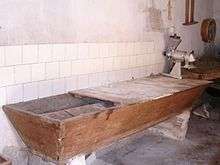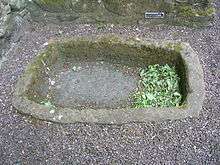Bread trough


A bread trough is a rectangular container with a shallow basin, used in traditional breadmaking in Europe. The wooden form has been used for centuries for making bread. It is variously called an "artesa" or "dough trough".[1]
Kneading-trough

A kneading trough (Hebrew: מִשְׁאַרְתּ mishereth) is a term for the vessel in which dough, after being mixed and leavened, was left to swell or ferment (Exodus 8:3; 12:34; Deuteronomy 28:5,17). The dough in the vessels at the time of The Exodus was still unleavened, because the people were compelled to withdraw in haste.((Eastons))
The first citation of kneading-trough in Oxford English Dictionary is Chaucer, The Miller's Tale, 1386. Flour was not stored, perhaps for fear of insect infestation, but kneaded into dough and baked into bread without delay. Kneading-troughs in the Miller's Tale are big enough for people to sleep in, and may be used as floating rafts.
Other uses
It has also been used for watering and feeding livestock, and in wine production.
Mechanization in bakeries and new technologies in bread ovens have mostly relegated the artesa to either recycling or as a garden box, excepting for weekends or more traditional or rural areas. Some small bakeries continue to use them.[2][3]
See also
| Wikimedia Commons has media related to Bread troughs. |
| Look up trough in Wiktionary, the free dictionary. |
References
- ↑ "Archived copy". Archived from the original on 2013-09-25. Retrieved 2013-09-02.
- ↑
- ↑ A Few Great Bakeries, WQED Pittsburgh/PBS documentary, 2015. Segment on the Columbus Baking Company, Syracuse, New York.